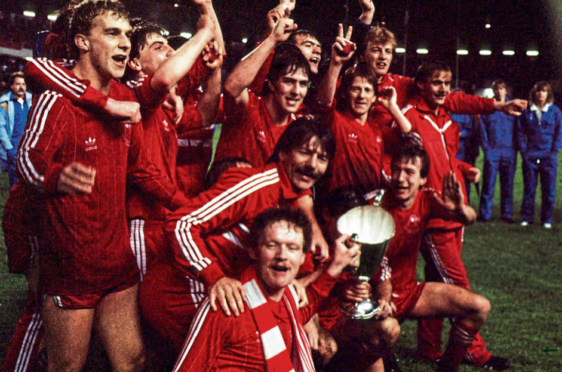Members of Aberdeen’s greatest team will reconvene at Pittodrie tonight on the 35th anniversary of their Cup-Winners’ Cup triumph to relive the day they conquered Europe.
May 11, 1983 is a date etched in the fabric of the club’s history and its significance continues to permeate all these years later. Just ask striker Stevie May, who wears squad number 83.
He should wear it with pride. So many Dons fans already do – and why not? It’s not every day you conquer Europe.
But that’s exactly what happened on the fateful rainy night in Gothenburg when Alex Ferguson, long before his knighthood, led a provincial team into history with a stunning 2-1 extra-time win against the mighty Real Madrid – the embodiment of the establishment in European football.
It was a night legends were born and for the man who lifted the trophy, former club captain and manager Willie Miller, John Hewitt’s winning goal was one which changed not only the perception of the Dons but the reputation of the players.
Miller said: “Winning in Gothenburg changed everything. We went from being obscure to a club that was known worldwide.
“We were a provincial club which nobody knew too much about and after winning the Cup-Winners’ Cup we were getting letters from Europe and Africa looking for souvenirs. That night changed the club, changed our stature as players and our standing in international football.”
While Miller had been part of the building process which led to the Dons winning the game, for some of the younger players, including winning goalscorer Hewitt, the significance of what they had achieved did not sink in at the time.
Miller added: “As a young player Eric Black thought you came in for pre-season training and at the end of the season you lifted a trophy. That’s how special a time it was.
“For the likes of Eric, Neil Simpson, Neale Cooper and John Hewitt it was a wonderful time for them. They walked in the door and the trophies started flowing through.”
Long before they reached the final, Ferguson had already taken a young promising team and turned the players from dreamers into believers.
On their date with destiny, Miller’s defensive partner Alex McLeish knew his team had the beating of their illus-trious opponents before the two teams had taken to the pitch. McLeish said: “We had Simmie, big Doug Rougvie and Coops all screaming and I could see the Real Madrid players all laughing in the tunnel but I could tell it was a nervous laugh. I knew then we had a greater team spirit than the Real Madrid team.”
The late Alfredo di Stefano, the Madrid manager at the time, knew it too and his quote after the game summed up the difference between the two teams which had led to a historic upset taking place. Di Stefano said: “Aberdeen have what money can’t buy – a soul, a team spirit built in a family tradition.” The players credit Ferguson and his assistant Archie Knox for their influence.
The Ferguson influence would extend to an unprecedented level after Pittodrie with Manchester United – and Miller is not surprised.
He said: “Alex was a bombshell to the players as he was pretty brash and open, but we could see he wanted what we wanted which was to overcome the Old Firm and lift trophies on a regular basis.”
McLeish agrees the management team was key but so too were the senior players especially when it came to indoctrinating the young players coming into the squad.
McLeish added: “It was a humble group of great players in that era. It was the fine details which brought us the success.
“Stewart Kennedy was a mentor for me. People talk about the hairdryer style of Ferguson and Knox but it wasn’t just that. The senior players drilled home the significance of having a winning mentality.”
